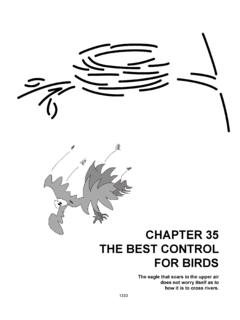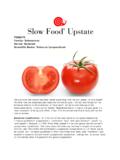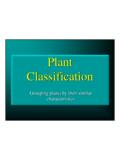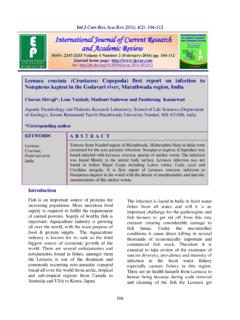Transcription of Chapter 26 - The Best Control for Barklice or …
1 1001 Chapter 26 THE best Control FORBARKLICE OR BOOKLICE OR PSOCIDS1002 Barklice OR BOOKLICE OR DUST LICE OR PSOCIDSA ppearance. Most species are free-living and not pests, but several species of book lice are found indoors, , the common booklouse- Liposcelis divinatorius (Mull). They are of rather similar appearance and they all have a superficial resemblance to some other lice species- hence their names. They are very small insects with soft bodies, cream to gray or light brown in color. Four wings (like cellophane) are usually absent from those found indoors although other outside species possess the two pairs. A pair of wing-pads may also be present.
2 In many species, males are absent, parthogenetic reproduction being the rule. Their antennae are long and thread-like, 11-50 segmented. The head is relatively large as are the antennae, but the eyes are poorly developed. The femora on the hind legs are enlarged as though it were able to leap, but such is not the case. The insect, however, can and does run quickly and it is this habit which usually causes the occupants to be aware of its presence. One interesting habit shown by the species Trogium pulsatorium (Linnaeus) is the tapping noise which it produces by vibrating its abdomen against a material such as paper.
3 It is probable that the first reference to the Death Watch concerned this book louse and not the wood-boring beetle. See also section in Chapter 29 on Stored Product Insects!ORDER - Psocoptera (previously called Corrodentia)FAMILIES - Trogium, Liposcelis, Lachesillia, Psyllipsocors, Lepinotus and PsocathroposTYPE METAMORPHOSIS - Gradual/simple or paurometabolous : The most common pests in homes are the booklice Liposcelis spp. and the Trogium pulsatorium (Linnaeus) or larger pale Trigiid or death watch. At least 287 species and at least 24 families are known just in the , but only about 20 are commonly found inside.
4 They run - Average of 57 eggs are laid by female, usually near a food source. Nymph - Resembles adult in appearance, but they are smaller in size. Adult - Fertile male and female but females can reproduce by parthenogenesis. They prefer dark, damp, warm and undisturbed locations. Adults are about 1/32 - 1/4 long with soft bodies- they look very much like miniature termite workers. Some are wingless like the common booklouse and others like the death-watch have very small scale-like wings. Both sexes may be found indoors or outdoors. Most indoor species do not develop full, functional wings. They feed on fungi, mildew and/or mold spores and occasionally on starchy MOUTHPARTS - ChewingDESCRIPTION - See - Usually no males are found as females can reproduce without them.
5 Booklice are minute, soft-bodied, wingless insects 1/25 to 1/13 long. Colorless to grayish or brown. They are not related in any way to lice and have chewing mouthparts. The other (winged) species are not usually found inside. Smaller than a trogiids have small scale-like wings and brownish spots on their pale colored bodies. The female can make a ticking sound by striking or tapping her abdomen against paper, etc. up to 5 - 6 times per - Booklice nymphs usually are colorless and become grayish as maturity is reached. Very minute insect. 1003 Usually goes through 3 - 4 molts. The Trogiid nymphs go through 5 - White to bluish-pearly , oval-shaped and sticky and covered with a crusty covering of whatever material on which they are laid singly; large, about 1/3 of size of the adult - Live both indoors and outdoors but they usually prefer damp, warm undisturbed situations.
6 When found on books, they are usually feeding on microscopic mold. Outdoors they inhabit bark where they feed on mosses and lichens. They can also be found in grass, leaves and damp OF INJURY - Presence in warehouses, cupboards, walls, boxes, paper, libraries, upholstered furniture, spanish moss, oats, homes, bees nests, etc. in large numbers causes visual concern. They feed on microscopic molds and can damage books when they eat the starchy glue, paste and sizing in the bindings and can damage the edge of pages. Dead bodies in the dust will probably contribute to asthma attacks. They also have been found feeding on the eggs of the Angoumois grain beetle.
7 They may visually upset POINTS - Inside they prefer damp, warm, undisturbed areas where microscopic mildews or molds grow. At times Booklice can be found in insect collections, stored foods, , cereals, on damp grain or flour and upholstered furniture. This is an indication the materials are too damp and molding. Use a dehumidifier and remove cardboard boxes, books and papers from damp storage areas. Booklice are often found under flat objects, , books, boxes, boards, loose wallpaper and in drawers, closets, and around old books and papers. They feed on microscopic molds and are prevalent in damp, humid situations because molds commonly grow in such a habitat.
8 Use a dehumidifier, a non-dripping air conditioner and/or PEST MANAGEMENT Control - Psocid Control is best achieved by simply reducing the food sources and lowering and keeping the humidity below 50%. There is no practical way to prevent them from entering your building, so the best and first approach is to find the reason for the moist condition and correct or reduce the moisture problems and/or to reduce the temperature. Stop or Control the micromolds and you Control this pest. Use a dehumidifier or air conditioner, increase air flow with fans, clean with enzymes and/or borax and/or raise the temperature and dry out the areas.
9 They desiccate very rapidly when warm temperatures are combined with relative humidities of less than 33%. When found on books or products, this means the books or products are moldy and need to be dried out in the hot sun or microwave them for 30 - 60 seconds, but the sun or microwave may damage some books and/or products. Vacuum the area thoroughly and seal all cracks and crevices with patching plaster and/or caulk. Dispose of all moldy articles. Use a small heater or hair dryer to warm and dry any infested localized areas - be sure to turn off the heater when any surface becomes too hot to touch. Raise the total temperature to 120o F.
10 Or below freezing for 1 hour for any article, room and/or building and you also destroy this pest. Try using pestisafes , , talcum powder or food-grade DE as a drying agent. If you insist on using a poison, use a non-volatile one that has a drying action such as boric acid or silica aerogel; then lightly dust in cracks and crevices, behind books, attics, crawls and other areas that preclude human/pet exposure; borax or sodium borate applied to the surface will often permanently Control the mold, fungus and mildew. Wear a respirator and proper safety equipment. Any household product that will Control fungi, , 2% formalin, salt water, borax, sodium borate, chlorine bleach or ammonia (but never in combination) solutions will also eliminate the mold/pest.







